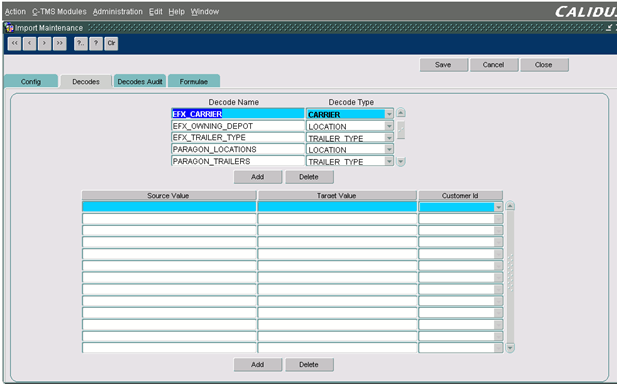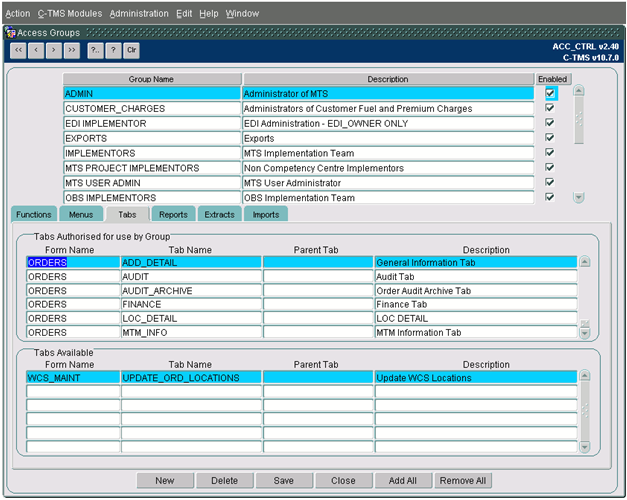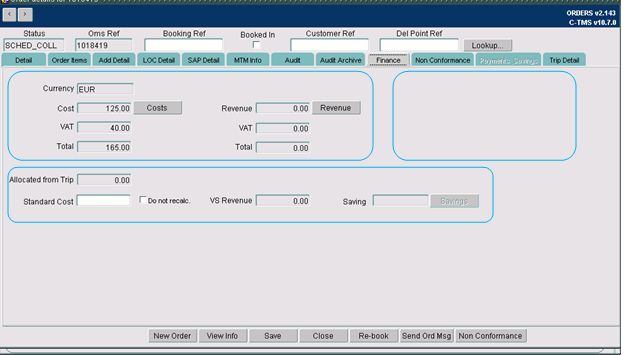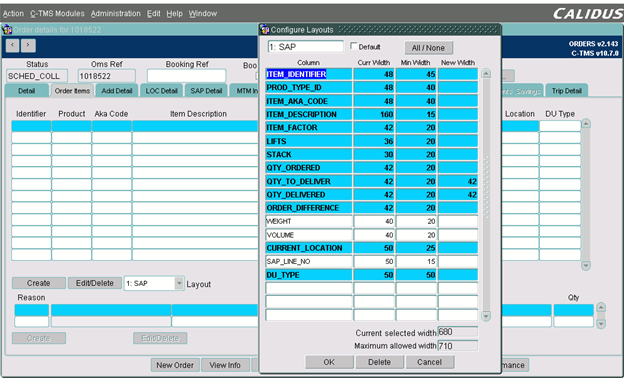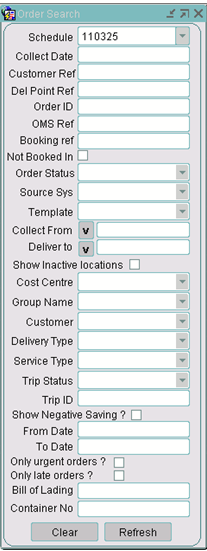286731
![]()
DHL MTS
Order Management
FUNCTIONAL SPECIFICATION - 10.6
- 2.0
Reference: FS 286731 DK-8EME2Y
Client Requirement
Change Request Summary:
Order Management.
Change Request Details:
Order Management - additional references, weighbridge ticket number, change dates, order search, redirect orders link to original.
Benefits identified as a result of the change:
Allow required customer information to be transferred into and held in the C-TMS database.
Solution
Order Management Changes:
Additional References: The requirement from the client is to capture specific references from GOLD, (the Openfield order management system), and passed through the interface to C-TMS. The data fields are not utilised in the planning process but are referenced constantly for supplier, product and haulier identification and many others.
The items currently identified are listed below (subject to confirmation of their sequence):
- Assurance Number
- Haulier Number
- Fixing Number
- Fixing Customer Reference
- Sale Grade
- Intake Reference
- Commodity Code
- Variety Code
- Contract Comments
- Bin Bay Lines
- Bin Bay Comments
- Purchase Number
- Pool
- Sales Number
- Sales Comments
- Purchase Grade
- Sales Commodity
- Weighbridge Ticket Number
- Redirected Original Order
Each of these items will be mapped to a sub-reference identifier and a decode value setup for name ‘ORDER_SUB_REFS’ and type ‘ORDER’; for example, the sub-reference identifier will be sent as ‘18’ in the XML file and this would be mapped via the decode table to ‘Weighbridge Ticket Number’, the sub-reference in the XML file would then be the value recorded for the weighbridge ticket number.
The ‘Order Details’ screen in the ‘ORDERS’ form in C-TMS will be changed to display the additional references in a new tab page with the heading ‘Add Refs’. This tab page will display the extra items received in the TripOrder XML file for v2.12.
The additional references will be displayed with the decoded values so that reference type and value is displayed in a table with two columns. The user will have the ability to add or delete references using the appropriate buttons marked with a ‘+’ or a ‘-‘ sign. Only one reference type may exist at a time as all of the additional references are expected to be updated via the XML file. A list of values based on the decoded values will be available for when new references are added.
The decode values may be setup in the ‘Decodes’ tab page of the ‘Import Maintenance’ screen in the ‘IMPORTS_MAINT’ form.
Fields are passed from GOLD via ESI interface and received into C-TMS. The references are made available on reporting against the trip and order level. The XML interface is described in RIO 286642 PM-8ELM6Z Integration Orders.
Weighbridge Ticket Number: Requirement for an additional field to be added against the order. Each load planned and transported by Openfield is either done by ‘own transport’ or subcontracted out to regional hauliers. The cost of moving a load is based on both distance to market and or weight. Loads are typically 29 tonnes in weight or up to the maximum vehicle capacity. Loads are weighed at the collection point or at weighbridge en-route and a weighbridge ticket produced. The ticket number is to be written on the driver manifest by the driver. Driver either faxes or posts back manifest to HQ. Number is scanned by Tokairo at the point of debriefing and the weighbridge ticket is uploaded to C-TMS utilising OCR technology (within Tokairo). All weighbridge tickets are double checked for accuracy prior to payment being released to haulier via EFX.
The weighbridge ticket number will be received in the XML file as an additional reference and displayed in the ‘Add Refs’ tab page.
N.B. It is expected that there will be only one weighbridge ticket number and value per order.
Change Date Function: This requirement stems from the operational activity of being able to amend collection or delivery dates on orders quickly. Whilst it is possible to cancel down an order and rebook for another day, the requirement is to select multiple orders simultaneously and amend the collection and or the delivery date in one function and allocate to haulier. At present there are no sense checks in place to ensure a haulier is not being double booked prior to performing this action or after the action has taken place. Phone calls will be placed with the haulier to check availability. To put this requirement into context, a number of loads may be booked for delivery to the docks but the arrival and, therefore, the loading dates of the ship have been estimated. On confirmation of a loading date being received, this will trigger the planning sequence to reschedule the planned delivery dates to dock for respective loads.
N.B. This requirement is outside the scope of this estimate and will now be handled in the Planning Changes: 286734 DK-8EMEWUTrip Planning
Order Search: The search criteria contained within the ‘Order Search’ function meets the requirements of the customer. A request has been put forward to make the ‘Order Search’ bar customisable to reduce the number of fields visible and have this configured by user settings.
The existing ‘Order Search’ window in the ‘ORDERS’ form will be changed to allow it to have a configurable layout as specified by the users. The configurable layout may be specified via a right-click option called ‘Configure Layout’ in the order well block in the ‘Order Summary’ screen in the ‘ORDERS’ form. There will be a window for the configurable layout available, like in the trip planning screens, in which the user may create their own layout by specifying which search fields are required. The window will display the search field to highlight to include, or de-highlight to exclude, the field (the widths are not required since the configurable layout will not display columns across the screen and the number of fields will not be changed so that the size of the existing ‘Order Search’ window will not be exceeded).
Redirect Order to Original: It can be common place a load moved from A to B arrives at B to find out the quality of the grain is not suitable for its end purpose. What might have been destined for milling wheat may now only be suitable for pet food due to high levels of moisture content. An onward delivery location should be factored in, e.g. location C. In reality the load has moved from A to B to C. The haulier will be paid the rate for travelling from A to B to C, but the client charged from A to B and from A to C. The additional legs need to be captured and be reported on, but has to link back to the original order reference. The solution requires both changes to how the financial aspects of the additional mileage is captured and recorded for haulier payments, etc but also to allow planned versus actual with these details being passed back to the host system GOLD via DHL LINK.
The redirected order number will be received in the XML file as an additional reference and displayed in the ‘Add Refs’ tab page.
Financial Data:
The ‘Order Details’ screen in the ‘ORDERS’ form in C-TMS will be changed to display additional fields in the ‘Finance’ tab page: there will be tick boxes with the titles ‘Capped Load’ and ‘Exception’ and numeric fields will be activated by the tick boxes to store the values respectively under the titles ‘Capped Tonnage’ and ‘Revenue per Tonne’.
The layout of the tab page will be changed to group the fields into blocks indicated by rounded rectangles:
- ‘Currency’ to ‘Total’ (Existing)
- ‘Allocated from Trip’ to ‘Saving’ (Existing)
- ‘Capped Load’ to ‘Exception’ (New)
Scope
This change will be applied to system version 10.6.
Set-up
Pre-requisites
The development for the upload of the additional references must be present as described in functional specification ‘FS-286642 PM-8ELM6Z Integration Orders v1.0.doc’.
Menu Structure
‘Unchanged’
Data
The new tab page called ‘Add Refs’ must be created and access provided to the appropriate user groups.
Functional Description
Order Management
The ‘Orders’ screen in the ‘ORDERS’ from will be changed to display more data received in the ‘TripOrder’ XML file for the upload of orders from GOLD into C-TMS.
Decoded Values
Decodes will be setup for the additional references for when they are received in the XML file.
The decode values may be setup in the ‘Decodes’ tab page of the ‘Import Maintenance’ screen in the ‘IMPORTS_MAINT’ form:
The ‘Decode Name’ will be ‘XML_REFERENCE’ and the ‘Decode Type’ will be ‘REFERENCE’; there will then be records to map the ‘Source Value’ (e.g. ‘1’) to the ‘Target Value’ (e.g. ‘Assurance Number’) and the ‘Customer Id’ will be blank.
Additional References
A new tab page called ‘Add Refs’ will be added to the ‘Orders’ screen to display the additional references.; the name of the tab page will be ‘ADD_REFS’ and it will be available for the ‘ORDERS’ form.
Access to this tab page will be granted to the appropriate user groups as authorised in the ‘Access Groups’ screen:
The items currently identified are listed below (subject to confirmation of their sequence):
| SUB_REF_NAME | SUB_REF_VALUE | Decoded Value |
| 1 | VARCHAR2(200) | Assurance Number |
| 2 | VARCHAR2(200) | Haulier Number |
| 3 | VARCHAR2(200) | Fixing Number |
| 4 | VARCHAR2(200) | Fixing Customer Reference |
| 5 | VARCHAR2(200) | Sale Grade |
| 6 | VARCHAR2(200) | Intake Reference |
| 7 | VARCHAR2(200) | Commodity Code |
| 8 | VARCHAR2(200) | Variety Code |
| 9 | VARCHAR2(200) | Contract Comments |
| 10 | VARCHAR2(200) | Bin Bay Lines |
| 11 | VARCHAR2(200) | Bin Bay Comments |
| 12 | VARCHAR2(200) | Purchase Number |
| 13 | VARCHAR2(200) | Pool |
| 14 | VARCHAR2(200) | Sales Number |
| 15 | VARCHAR2(200) | Sales Comments |
| 16 | VARCHAR2(200) | Purchase Grade |
| 17 | VARCHAR2(200) | Sales Commodity |
| 18 | VARCHAR2(200) | Weighbridge Ticket Number |
| 19 | VARCHAR2(200) | Redirected Original Order |
The ‘Decoded Value’ will be the name of the column and the ‘SUB_REF_VALUE’ will be displayed as obtained from the XML tag of that name for the order on the table ‘SCH_ORD_REFERENCE’.
It is expected, at present, that 19 sub-references will be received via the XML file.
The layout of the new tab page will be dependent on the decoded values setup as they will be displayed in the sequence of the records in the ‘Decodes’ tab page.
The data will be displayed in two columns for the ‘Target Value’ of the decoded ‘SUB_REF_NAME’ value as the ‘Additional Reference’ and the ‘SUB_REF_VALUE’ received in the XML file:
| Additional Reference | Value |
| IMP_DECODE_ENTRY.TARGET_VALUE | SCH_ORD_REFERENCE.SUB_REF_VALUE |
A vertical scrollbar will be available should more additional references exist than can be displayed in a single screen.
Each additional reference may be amended in the screen, records may also be inserted or deleted using the ‘+’ or ‘-’ buttons provided at the top of the screen.
Only one reference type may exist at a time as all of the additional references are expected to be updated via the XML file. A list of values based on the decoded values will be available for when new references are added, therefore the user may view the ‘Source Value’ and the ‘Target Value’ of the decoded values when a record is being added.
Financial Data
The ‘Order Details’ screen in the ‘ORDERS’ form in C-TMS will be changed to display additional fields in the ‘Finance’ tab page: there will be tick boxes with the titles ‘Capped Load’ and ‘Exception’ and numeric fields will be activated by the tick boxes to store the values respectively under the titles ‘Capped Tonnage’ and ‘Revenue per Tonne’.
For greater clarity, the layout of the tab page will be changed to group the fields into blocks indicated by rounded rectangles:
- ‘Currency’ to ‘Total’ (Existing)
- ‘Allocated from Trip’ to ‘Saving’ (Existing)
- ‘Capped Load’ to ‘Exception’ (New)
All of the existing values displayed are from items on data block ‘SCH_ORD_UPD’ from table ‘SCH_ORD’ and the new fields ‘Capped Load’, ‘Capped Tonnage’, ‘Exception’ and ‘Revenue per Tonne’ will be added to this data block as ‘query data source columns’ for updating.
The ‘Capped Load’ tick box indicates the maximum tonnage that may be transported by the trailer on the trip and the ‘Capped Tonnage’ will be stored in whole metric tonnes. The ‘Capped Tonnage’ title and field will be inactive unless ‘Capped Load’ has been ticked.
The ‘Exception’ tick box indicates if a different rate has been agreed for the trip and the ‘Revenue per Tonne’ will be stored in pounds and pence. The ‘Revenue per Tonne’ title and field will be inactive unless ‘Exception’ has been ticked.
The data will be obtained from the following columns on the ‘SCH_ORD’ table:
| Field | Column |
| Capped Load | CAPPED_LOAD |
| Capped Tonnage | CAPPED_TONNAGE |
| Exception | EXCEPTION |
| Revenue per Tonne | REVENUE_PER_TONNE |
The layout of the new section will be where ‘x’ represents the tick boxes:
Capped LoadxCapped Tonnage 29
ExceptionxRevenue per Tonne150.25
Order Search
The existing ‘Order Search’ window in the ‘ORDERS’ form will be changed to allow it to have a configurable layout as specified by the users.
The configurable layout may be specified via a right-click option called ‘Configure Layout’ in the order well block in the ‘Order Summary’ screen in the ‘ORDERS’ form.
The popup menu ‘ORDER_MENU’ is available for the items in the ‘ORD_SUMMARY’ data block (i.e. fields ‘Schedule’, ‘Booking Ref’, ‘Status’ and ‘Type’ in the ‘Order Summary’ screen) and the item ‘CONFIGURE_BLOCK’ will be added with the title ‘Configure Layout’.
There will be a window for the configurable layout available, like in the trip planning screens, in which the user may create their own layout by specifying which search fields are required. This window will be called via the ‘Configure Layout’ right-click option.
The window will display the search parameter to highlight to include, or de-highlight to exclude, the parameter (the widths are not required since the configurable layout will not display columns across the screen and the number of fields will not be changed so that the size of the existing ‘Order Search’ window will not be exceeded as it fills the screen).
An example of the existing configurable layout selection for the order items is shown below and this configurable layout will not be changed:
A similar layout will be used so that the user may select parameters to display.
This will require new data blocks, a new package, a new canvas and a new window for the attributes of the second configurable layout available in the form: the data blocks may be called ‘ATTRIBUTES_2’ and ‘ATTRIBUTES_CTRL_2’; the package may be called ‘FC_ATTRIBUTES_2’; the canvas may be called ‘ATTRIBUTES_2’ and the window may be called ‘ATTRIBUTES_2’.
The ‘ATTRIBUTES_2’ data block will be related to the ‘ORDER_SEARCH’ data block for the order search parameters.
The visual differences between the configurable layouts for the new configurable layout will be:
- The columns ‘Curr Width’, ‘Min Width’ and ‘New Width’, plus the fields ‘Current selected width’ and ‘Maximum allowed width’, will be removed as they are not required for a vertical layout.
- The title ‘Column’ will be renamed ‘Parameter’.
- The parameter items will be displayed in the ‘Parameter’ column.
At least one parameter must be selected and an error message will be displayed if there are none highlighted.
The current ‘Order Search’ parameters are displayed below and all parameters will be available in the configurable layout:
A new dropdown field with the title ‘Layout’ will be added at the top of the ‘QRY_ORDERS’ canvas (i.e. the ‘Order Search’) so that the user may specify a layout; if the layout is changed then the new layout will be displayed automatically.
Each parameter will be a consistent distance from the next parameter and the size of the window will be calculated so that it may be decreased or increased as different parameters are selected or deselected. The titles, tick boxes, buttons (i.e. ‘v’) and fields will need to be separate items in the window with the tick boxes and fields being used in the configurable layout selection.
Any dropdown list of values and validation for the fields will still be available in the ‘Order Search’ screen as only the number of parameters may vary; however, a change will be made to exclude the initialisation of the search criteria for parameters not selected for display to increase the efficiency of the processing.
The ‘Clear’ and ‘Refresh’ buttons will be retained and they will appear at the bottom of the resized window.
The attributes for the configurable parameters will be stored on the existing tables ‘ADM_MSEL_FORM‘ (for the user) and ‘ADM_MSEL_FORM_PARAM’ (for the selected parameters in the specific data block by the user).
The data retrieval of the orders need not be changed as the order search parameters are optional.
N.B. Any future development may require the introduction of a limit to the number of parameters that may be selected for display in the ‘Order Search’ screen, or the introduction of a scrollbar to allow more parameters to be displayed and be available.
Table Updates Required
The ‘SCH_ORD’ table will be changed to include the new columns using the following script:
ALTER SCH_ORD ADD CAPPED_LOAD VARCHAR2(1);
ALTER SCH_ORD ADD CAPPED_TONNAGE NUMBER;
ALTER SCH_ORD ADD EXCEPTION VARCHAR2(1);
ALTER SCH_ORD ADD REVENUE_PER_TONNE NUMBER(8,2);
The new ‘Add Refs’ tab page may be added using the following script:
-- Update table insert into adm_form_tab (form_name, tab_name, description) values ('ORDERS','ADD_REFS','Add Refs')
References
| EST-286731 DK-8EME2Y Order Management v1.0.doc | |||
Glossary
| C-TMS | Calidus TMS |
Document History
| Initial version | ||||
| Reviewed and Issued | ||||
| Added script to add the new tab page | ||||
| Re-issued | ||||
AUTHORISED BY
| Matt Crisford | Development Manager | |
| Peter Greer | TMSCC MTS Product Manager |
